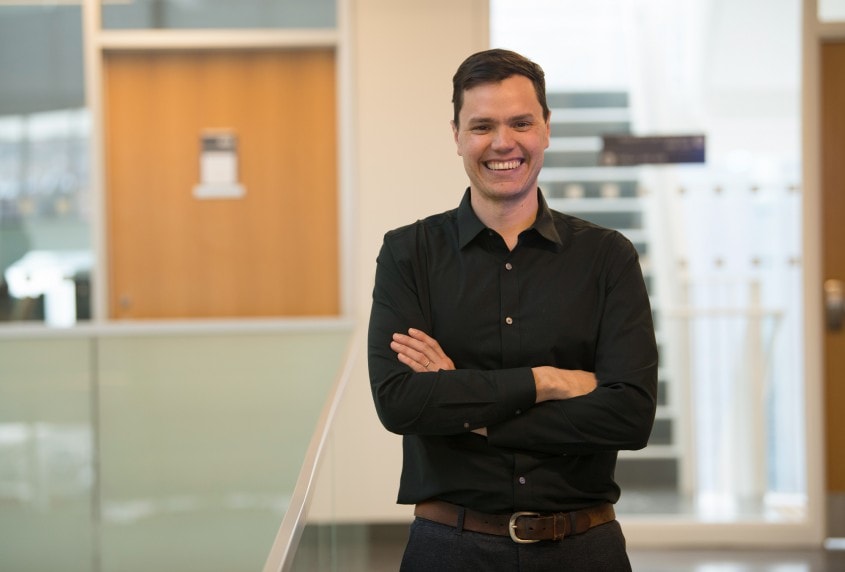A three-part series by a Niagara environmental scientist is shining the spotlight on the causes and the future of climate change.
Dr. Adam Martin’s first talk in “The Changing World” series at the Niagara-on-the-Lake Public Library sparked plenty of conversation among the engaged audience.
Originally from Welland, Martin is an assistant professor at the University of Toronto in the Centre for Critical Development Studies.
A friendly face around Niagara-on-the-Lake, he can often be found working in the library or volunteering at community events, like last month’s Jane’s Walk.
His first library lecture drew many local environmental enthusiasts, including Coun. Sandra O’Connor and Jo-Ann Fraser, who leads the NOTL Jane’s Walk.
Asked if they could think of a recent news story about climate change, the audience quickly came up with several examples: flooding in Sydney, historic droughts in California, wildfires in Europe.
“It’s hard to keep up with the climate change-related news,” said Martin.
“Students that I’m teaching have family back in Pakistan. There’s tremendous flooding there – the prime minister has said the whole country looks like a sea.”
Climate and weather are fundamentally different. Weather describes short-term conditions in the atmosphere on the scale of hours to days.
“It’s really short-term events: temperature, precipitation, wind … All of the stuff you check online before you walk out the door,” said Martin. “There’s no historical context around it.”
On the contrary, climate describes how the atmosphere is expected to behave over long periods of time: years, decades, even centuries.
Climate change makes that behaviour “less and less predictable,” said Martin, “because it’s starting to deviate from this historical pattern.”
As most of us know, the burning of fossil fuels has greatly warmed the atmosphere.
“The science is very settled in this,” said Martin. He explained how human activities release greenhouse gases like carbon dioxide (CO2), which trap excess heat in the atmosphere and make the Earth’s surface less reflective for solar rays.
Scientists can determine how much CO2 was in the atmosphere at different times in history. “We can examine ice cores and figure out how much CO2 is trapped in the bubbles way down there,” he said.
We now know that in 2018, atmospheric CO2 levels reached the highest levels in 800,000 years. The biggest sources of emissions are energy extraction and consumption, and industries like agriculture and forestry.
Without human contributions to greenhouse gases, historical data indicates that the Earth was actually in a cooling phase.
“From about 1,000 years ago, there’s this cooling trajectory. And then whammo,” said Martin.
Since industrial activity took off, “over about the last 150 years, we’ve seen global average temperatures go up by about 1.5 degrees.”
Changes in temperature and precipitation have been monitored worldwide, using a network of more than 30,000 measurement stations.
Some regions are warming much more quickly: like the Arctic, where temperatures have risen 1.7C to 2.5C above historical averages. “That’s a tremendous amount of warming in a short time,” said Martin.
He also described the fascinating science of climate modelling. “It’s a ton of equations in a computer program that describe in math terms how climate works.”
Many fields use predictive models to forecast future trends, including house prices or stock market behaviour.
Climate models incorporate principles in atmospheric physics, chemistry and ocean circulation patterns to predict how climate will behave under certain conditions.
When models incorporate human factors like greenhouse gas emissions, they almost exactly replicate the observed increases in temperature. Without human contributions, the predicted climate would be much cooler and calmer.
The discussion continued with insightful audience comments. Dr. Gordon Young, professor emeritus at Wilfrid Laurier University, raised the important point that world population contributes greatly to climate change.
At the same time, developing nations with rapidly increasing populations are likely to be hit hardest by climate change impacts and often do not have the resources to adapt or rebuild in the wake of disaster.
A side conversation also emerged about the staggering carbon footprint of data storage and the internet itself.
“In 2019, the amount of electrical energy used for mining cryptocurrency was equivalent with the consumption of Ireland or Czechoslovakia,” said one person.
“And that’s just cryptocurrency mining, not Google,” said another. “Or pictures of your dog.”
Clearly, there is more to the climate conversation and it will continue at the library on Tuesday, Oct. 25, at 6:30 p.m. Martin’s next talk is about the future of our climate.
The first presentation is available on the library’s YouTube channel.
Kyra Simone is a PhD student in environmental science, with master’s degrees in biology and science communication. When not researching climate change, she advocates for a sustainable future, picks up litter and makes recycled jewelry.











